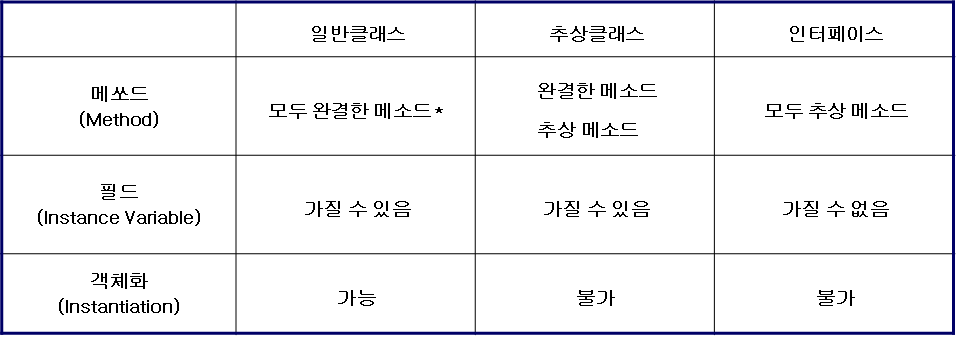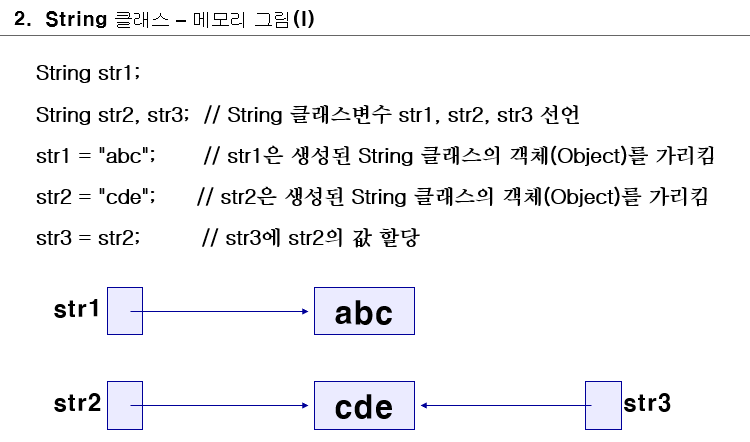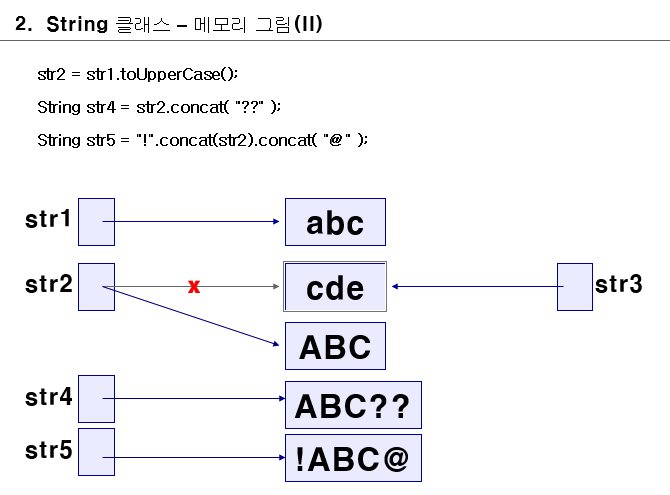객체지향 Ch.3-3 상속과 다형성~ Ch.4-4 String Buffer
더존비즈온양성과정

Ch.3-3 상속과 다형성
상속 이유
재사용성 , 중복 제거, 계층적 분류 및 관리
특징
다중 상속 불가 (부모 여러명x)
메소드 오버라이딩
오버라이딩시 부모클래스 메소드 무시하고 자식 메소드 실행
상속했을 때 생성자 특징
- 지시가 없으면 자식 클래스에서도 부모 클래스의 기본 생성자 호출
- super()를 이용한 명시적 부모 클래스 생성자 호출(자식 생성자 코드 뒤에 호출 x)
부모 클래스(Point) 생성자
public Point(int x, int y) {
this.x = x;
this.y = y;
}자식 클래스(ColorPoint) 생성자
public ColorPoint(int x, int y, String color) {
super(x,y);
this.color = color;
//super(x,y) : 오류
}객체의 형변환
업캐스팅
자식클래스가 부모클래스 타입으로 변환되는 것
명시적으로 타입 변환을 하지 않아도 된다.
다운 캐스팅
업캐스팅 된 것을 원래대로 되돌리는 것
명시적으로 변환해야함
public class StudentTest {
public static void main(String[] args) {
Student s1 = new Student();
s1.setGrade(1);
Person p1 = s1; //upcasting(암시적,Implicity)
p1.setName("둘리");
Student s2 = (Student)p1; //downcasting(명시적, explicity)
s2.setMajor("cs");
}
}Ch.3-4 추상 클래스와 인터페이스
추상 클래스
실체 클래스의 공통적인 특성들을 추출해 선언한 클래스
객체 직접 생성해서 사용 불가
확장을 위한 용도
하나 이상의 추상 메소드를 가진다 (없으면 자식클래스에 선언해야함)
-> 추상 메소드가 없어도 추상 클래스일 수 있음
인터페이스
클래스들 사이의 유사한 특성(변수,메소드)을 부자연스러운 상속 관계를 설정하지 않고 얻어냄
특징
다중 상속 가능 (+ 인터페이스 간 다중 상속 가능)
인터페이스를 구현한 클래스에서 추상 메소드 반드시(인터페이스에 선언한 메소드) 정의해야 함
Ch.3-4-6 일반클래스 vs 추상 클래스 vs 인터페이스

ch.3-4-7 Instanceof 연산자
System.out.println(circle instanceof Object); // circle이 Object클래스의 인스턴스인지
System.out.println(circle instanceof Shape); //circle이 Shape클래스의 인스턴스인지
System.out.println(circle instanceof Circle);
// 오류: class는 hierachy 상위와 하위만 instanceof 연산자를 사용할 수 있다.
// System.out.println(circle instanceof Rectangle); : 오류 구문
//interface는 hierachy와 상관없이 instanceof 연산자를 사용할 수 있다.
System.out.println(circle instanceof Drawable); // circle이 Drawable 인터페이스를 구현했는지
System.out.println(circle instanceof Runnable);// circle이 Runnable 클래스의 인스턴스인지결과값
true
true
true
true
false
Ch.3-6 예외 처리
예외처리가 유용한 경우
1) 파일을 다루는 경우
해당 파일이 존재하지 않거나 다른 프로세스에 의해 사용중인 경우 예외 발생
2) 입출력을 다루는 경우
이미 닫힌 입출력 스트림에 대해 작업하려 할 경우 예외 발생
3) 네트워크을 통한 데이터 통신
서버나 클라이언트 한 쪽에서 응답이 없는 경우
네트워크 상태가 안 좋아서 정해진 시간동안 데이터를 받지 못하는 경우
사용자 정의 예외
예외의 최상위 클래스인 Exception 클래스를 상속받아 새로운 예외를 정의할 수 있음
일반적으로 생성자만 구현
Ch4 자바 기본 API
Point p = new Point(10,20);
//Class klass = p.getClass();
System.out.println(p.getClass()); //refrection
System.out.println(p.hashCode()); // address 기반의 해싱값
// address x
// reference x
System.out.println(p.toString()); //getClass() + "@" + hashCode()
System.out.println(p);toString 코드
public String toString() {
return "Point [x=" + x + ", y=" + y + "]";
}결과값
class chapter04.Point
1291
Point [x=10, y=20]
Point [x=10, y=20]
.getClass() : 현재 참조하고있는 클래스 확인가능
.hasCode() : address기반의 해싱값 확인
동일성 vs 동질성
동일성 비교 : ==
동질성 비교 : 객체1.equals(객체2)
Point p1 = new Point(10,20);
Point p2 = new Point(10,20);
Point p3 = p2;
// == : 두 객체의 동일성을 비교
System.out.println(p1 == p2);
System.out.println(p2 == p3);
// equals : 두 객체의 동질성 비교(내용비교)
// 부모 클래스 Object의 기본 구현은 동일성(==) 비교와 같다.
System.out.println(p1.equals(p2));
System.out.println(p2.equals(p3));결과
false
true
true
true
Ch4. 1-3 String Class
특수 문자 표현 및 출력
C:\temp 출력
System.out.println("c:\temp");
"hello" 출력
System.out.println("\"hello\"");
string관련 API

String s1 = "abc";
String s2 = "def";
String s3 = s2;
s2 = s1.toUpperCase();
String s4 = s2.concat("??");
String s5 = "!".concat(s2).concat("@");
System.out.println(s1);
System.out.println(s2);
System.out.println(s3);
System.out.println(s4);
System.out.println(s5);결과
abc
ABC
def
ABC??
!ABC@

StringBuffer
1.가변크기의 버퍼를 가짐
2. String 객체가 한 번 만들어진 문자열을 수정할 수 없는 것과는 달리 StringBuffer 객체는 수정 가능하다. ( 스트링 버퍼의 크기는 문자열 길이에 따라 가변적으로 변한다)
//String s1 = "Hello " + "World " + "Java" + 1.8; 이후에 문자열 추가못함
String s1 = new StringBuffer("Hello ")
.append("World ")
.append("Java ")
.append(1.8)
.toString();마지막에 .toString() 붙여주면서 String 자료형으로 변경된다.
